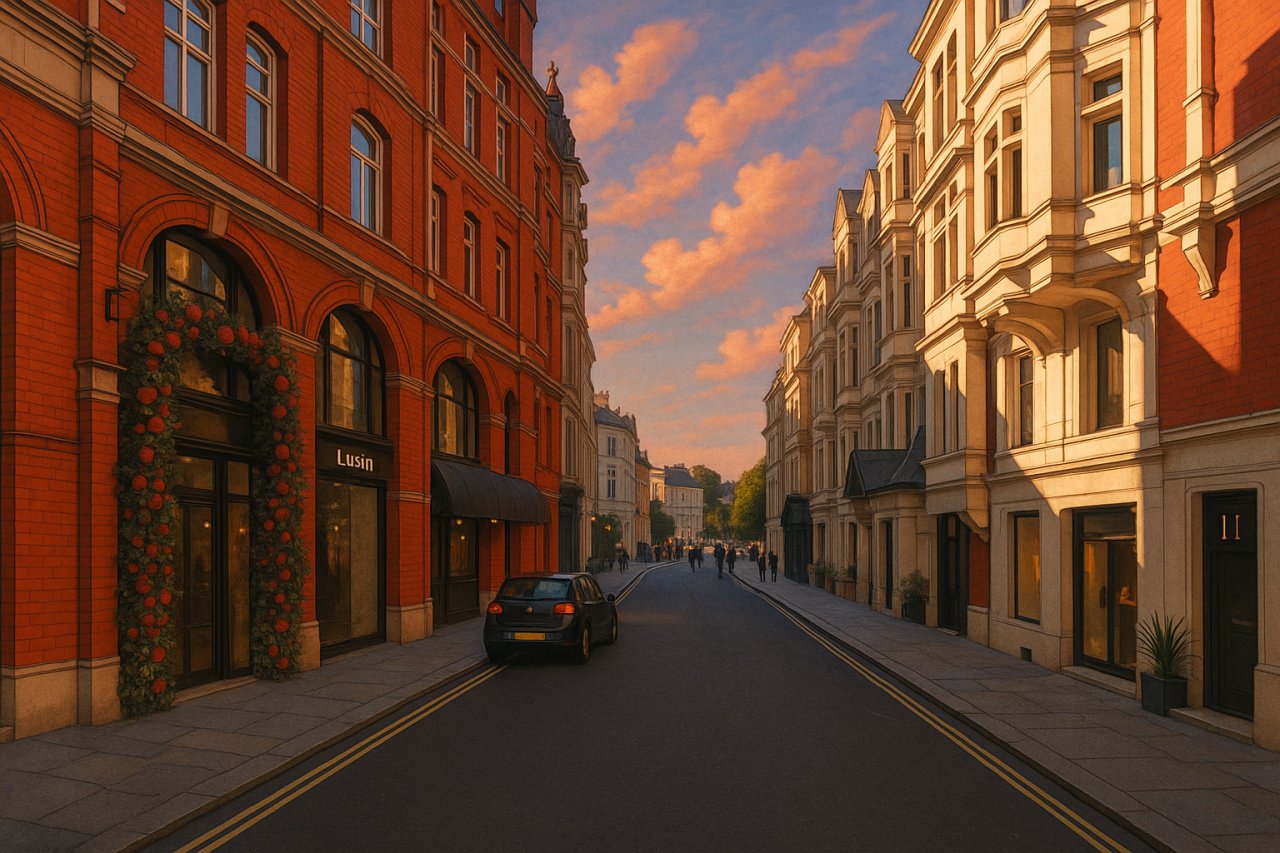
Hay Hill, London
Hay Hill is a discreet yet refined street located in the heart of Mayfair, within the City of Westminster. Despite its modest length of only 77 metres (252 feet), it occupies a prestigious location that links two notable parts of central London: Berkeley Square to the west and Dover Street to the east.
Location and Layout
Hay Hill runs as a one-way street from east to west, beginning at Dover Street and terminating at Berkeley Square. It is a narrow, two-lane carriageway bordered by elegant buildings, many of which are either private clubs, luxury offices, or art galleries. The street's compact length makes it easily walkable, offering a brief but pleasant stroll through one of London's most exclusive quarters.
Berkeley Square and Surrounding Roads
At the western end of Hay Hill lies Berkeley Square, a historic green space surrounded by grand Georgian buildings. The square is known for its plane trees, some of which are among the oldest in London, and its longstanding status as a centre of affluence. Roads near Hay Hill include Berkeley Street, Hill Street, and Curzon Street, all of which reinforce the high-end character of the neighbourhood.
Pronunciation and Name Origin
The name Hay Hill is pronounced “hay hill” /heɪ hɪl/  . The origin of the name is believed to derive from open land once used for the storage or sale of hay during a period when Mayfair was still semi-rural. As the area developed in the 18th century, streets were formalised and named accordingly. Hay Hill appeared on maps from the mid-1700s, suggesting its formal layout was part of Mayfair’s westward urban expansion.
. The origin of the name is believed to derive from open land once used for the storage or sale of hay during a period when Mayfair was still semi-rural. As the area developed in the 18th century, streets were formalised and named accordingly. Hay Hill appeared on maps from the mid-1700s, suggesting its formal layout was part of Mayfair’s westward urban expansion.
Character and Atmosphere
The atmosphere of Hay Hill is one of quiet exclusivity. Although only a short cut-through, it has long attracted luxury-focused tenants and private businesses. The buildings are typically low-rise, ranging from three to five storeys, and showcase a blend of late Georgian and early Victorian architectural styles, often with ornate stonework and iron railings.
Hay Hill Club, a private members' club catering to entrepreneurs and professionals, adds to the street’s air of discretion and distinction. Nearby art galleries and stylish office spaces also contribute to the refined environment, making Hay Hill a niche destination for connoisseurs of understated elegance.
Nearby Sights and Attractions
Though tiny, Hay Hill places visitors in close proximity to some of Mayfair’s most recognisable attractions:
- Berkeley Square – A historic garden square with notable plane trees and stately architecture.
- Dover Street – Known for high-end fashion boutiques and contemporary art galleries.
- The Royal Academy of Arts – Located just a short walk away in Burlington House on Piccadilly.
- Green Park – One of London’s Royal Parks, offering open green space just minutes to the south.
Real Estate and Property Prices
Real estate along Hay Hill is among the most exclusive in the City of Westminster, with limited stock and high demand. As of early 2025, commercial spaces and luxury flats command extraordinary values, reflective of the street’s elite location in Mayfair.
Premium office suites along the street have been listed for around £2,000 to £2,800 per sq ft (£21,500 to £30,140 per sq m), with entire buildings sometimes reaching over £15 million, depending on their size and heritage. Residential flats, where available, are typically large by London standards, often starting at 1,500 sq ft (approximately 139 sq m) and priced well above £5 million.
Transport Links
Nearest London Underground Stations
The street is conveniently located for several London Underground stations:
- Green Park Station – About 4 minutes' walk south, served by the Jubilee Line, Piccadilly Line, and Victoria Line.
- Bond Street Station – Roughly 10 minutes’ walk to the north, served by the Jubilee Line and Central Line.
- Piccadilly Circus Station – A 12-minute walk away, served by the Piccadilly Line and Bakerloo Line.
Nearby Bus Stops
The nearest bus stops are located along Piccadilly and Berkeley Street, offering services that connect to St James’s, the City, and the West End. These stops are served by several Transport for London routes, including routes 8, 14, 19, and 38.
Historical Note
During the 18th century, Hay Hill and its surroundings developed rapidly as aristocratic families began commissioning townhouses in the newly fashionable Mayfair district. One fascinating anecdote is that, for a time in the 19th century, Hay Hill was known locally for its cut-through access used by servants and delivery carriages bound for the houses of Berkeley Square.
Fun Fact
Though Hay Hill is often passed by without much fanfare, it is sometimes used as a filming location for period dramas due to its well-preserved historic architecture and lack of heavy foot traffic. Its discreet charm has also made it a favourite for high-end brands seeking private showroom space.
Quick Facts
- Street Name: Hay Hill
- Location: Mayfair, City of Westminster, London
- Length: 77 metres (252 feet)
- Traffic Direction: One-way (east to west)
- Nearby Landmarks: Berkeley Square, Dover Street, Green Park
- Architecture: Georgian and Victorian-era buildings
- Character: Discreet, upscale, with art galleries and private clubs
- Nearest Tube Stations: Green Park Station, Bond Street Station
- Bus Stops: On nearby Piccadilly and Berkeley Street
- Real Estate Price (2025): £2,000–£2,800 per sq ft (£21,500–£30,140 per sq m)
- Pronunciation: “hay hill” /heɪ hɪl/
Map of Hay Hill, London

Painting of Hay Hill, London (View image in full size)